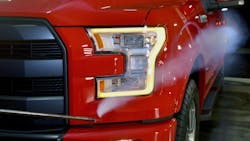Improved Aerodynamics on F-150
Ford Motor Co.’s “air curtain technology,” first used on its retooled Mustang sports car, is now being applied to its F-150 pickup truck line.
Those “curtains” allow air to flow through a vent underneath the head lamps and out around the wheel, noted Rob Lietz, Ford’s technical expert in applied computational fluid dynamics – ultimately reducing “wind drag” by guiding airflow across the front wheels.
Rotating wheels are a major source of aerodynamic drag, yet enclosing a pickup truck’s wheels in skirts to smooth out the airflow isn’t necessarily practical or attractive.
Thus Lietz and team adopted a new approach to this aerodynamic issue.
Their solution: horizontal slots underneath the head lamps channel air from the front of the truck through ducting to openings in the wheel wells – directing it across the outer surface of the wheel and tire.
“The wall of high-speed air works much like a skirt to reduce drag, while still leaving the alloy wheels fully exposed,” Lietz explained.
Of course, that’s just one little tweak in the F-150’s overall aerodynamic profile, which includes:
- Flush-mounted windshield that eliminates need for molding that would disrupt smooth airflow;
- Tailgate top is designed to act as a spoiler, giving air that flows off the roof a place to land before smoothly trailing off – reducing turbulence behind the truck;
- A cargo box that is narrower than the cab, with no reduction in box volume, which enhances airflow, while a trim piece prevents air from getting trapped between cab and box;
- Rear corners including tail lamps that are precisely angled so air breaks off cleanly – again, helping reduce turbulence behind the truck;
- Placing a duct under each head lamp to channel air through to the wheel-housing and reduces the wake generated from the wheel.
And it’s those tweaks – plus many others – that, when added to more fuel efficient engines, transmissions, and the lighter aluminum body of the 2015 F-150 lineup that translate into greater fuel savings.
Indeed, Ford said Environmental Protection Agency (EPA) fuel economy tests indicate a 2015 4x2 model F-150 equipped with a 2.7-liter EcoBoost V6 engine achieved a fuel economy rating of 19 mpg in city driving and 26 mpg in highway driving for a 22 mpg combined rating.
And this for full-size pickups under 8,500 lbs. GVWR! Certainly not the kinds of fuel numbers you’d expect a pickup truck to attain, though Ford stressed those numbers vary significantly based on payload, if anything’s being towed, etc.
